Picture this: you step into your backyard, greeted by a burst of vibrant blooms and the sweet fragrance of Hawaiian flowering trees, instantly transporting you to a tropical paradise. 🌞 Whether you’re a seasoned gardener or a beginner dreaming of a lush, island-inspired landscape, Hawaiian flowering trees offer unmatched beauty, cultural significance, and ecological benefits. In this comprehensive guide, I’ll share my expertise as a certified arborist and tropical plant enthusiast to help you select, plant, and care for 10 stunning Hawaiian flowering trees that will elevate your garden. From the iconic Ohia Lehua to the fragrant plumeria, this article provides practical tips and expert insights to create your own tropical oasis. Let’s dive into the world of tropical blooms and transform your outdoor space! 🌴
Why Choose Hawaiian Flowering Trees? 🌸
Hawaiian flowering trees are more than just eye-catching additions to your garden—they’re a celebration of nature, culture, and sustainability. Their vibrant colors, unique shapes, and year-round blooms make them a favorite for homeowners and landscapers alike.
Cultural and Aesthetic Appeal
In Hawaii, flowering trees like the plumeria and Ohia Lehua are woven into the fabric of daily life, used in leis, ceremonies, and as symbols of aloha. 🌺 Their vivid hues—reds, yellows, pinks, and even turquoise—create a visual feast that transforms any garden into a tropical retreat. Whether you’re aiming for a single statement tree or a vibrant ensemble, these trees deliver unmatched aesthetic appeal.
Environmental Benefits
Beyond beauty, these trees support local ecosystems. They attract pollinators like bees, butterflies, and native birds, fostering biodiversity. 🐝 Many, like the Royal Poinciana, provide cooling shade, reducing energy costs in warm climates. Others, such as the Hibiscus Tree, stabilize soil and thrive in coastal areas, making them ideal for eco-conscious gardeners.
Versatility for Gardens
Hawaiian flowering trees suit a range of garden sizes, from compact patios to sprawling estates. Smaller trees like the Golden Trumpet Tree fit urban spaces, while larger ones like the Rainbow Shower Tree create dramatic focal points. With proper care, some can even thrive in non-tropical climates using containers or microclimates.
Top 10 Hawaiian Flowering Trees for Your Garden 🌼
Here’s a curated list of 10 breathtaking Hawaiian flowering trees, complete with descriptions, growing conditions, and care tips to ensure success.
1. Ohia Lehua (Metrosideros polymorpha)
The Ohia Lehua is a Hawaiian icon, known for its vibrant red or yellow pom-pom flowers. Sacred in Hawaiian mythology, it’s tied to the volcano goddess Pele. This resilient tree thrives in diverse conditions, from volcanic slopes to coastal gardens.
- Growing Conditions: Prefers well-drained soil, tolerates wet or dry climates.
- Care Tips: Prune lightly to maintain shape, water moderately, and monitor for fungal diseases.
- Expert Insight: Dr. Lani Stemmermann, a Hawaiian botanist, notes, “The Ohia Lehua is a keystone species, supporting native birds and insects critical to Hawaii’s ecosystems.” 🌋

2. Plumeria (Plumeria spp.)
Plumeria’s fragrant, star-shaped blooms in white, pink, or yellow are synonymous with Hawaiian leis. These small trees or shrubs are perfect for beginners due to their low maintenance.
- Growing Conditions: Full sun, well-drained soil, drought-tolerant once established.
- Care Tips: Fertilize monthly during growing season, protect from frost in cooler climates, and propagate via cuttings.
- Example: To propagate, cut a 12-inch stem, let it dry for a week, and plant in sandy soil for a new tree within months. 🌸

3. Rainbow Shower Tree (Cassia x nealiae)
The Rainbow Shower Tree, Honolulu’s official tree, boasts cascading blooms in pink, yellow, and white. Its vibrant display makes it a showstopper for urban gardens.
- Growing Conditions: Warm climates, moderate water, full sun.
- Care Tips: Prune annually to maintain shape, avoid overwatering to prevent root rot.
- Fun Fact: This hybrid was developed in Hawaii for its non-invasive nature, unlike other cassia species.
4. Hibiscus Tree (Hibiscus tiliaceus)
Also called Hau, this tree features heart-shaped leaves and yellow flowers that fade to pink by day’s end. It’s ideal for coastal landscapes due to its salt tolerance.
- Growing Conditions: Full sun to partial shade, moist soil.
- Care Tips: Prune to control spread, water regularly, and check for aphids.
- Use Case: Perfect for creating natural privacy screens near beaches. 🌊
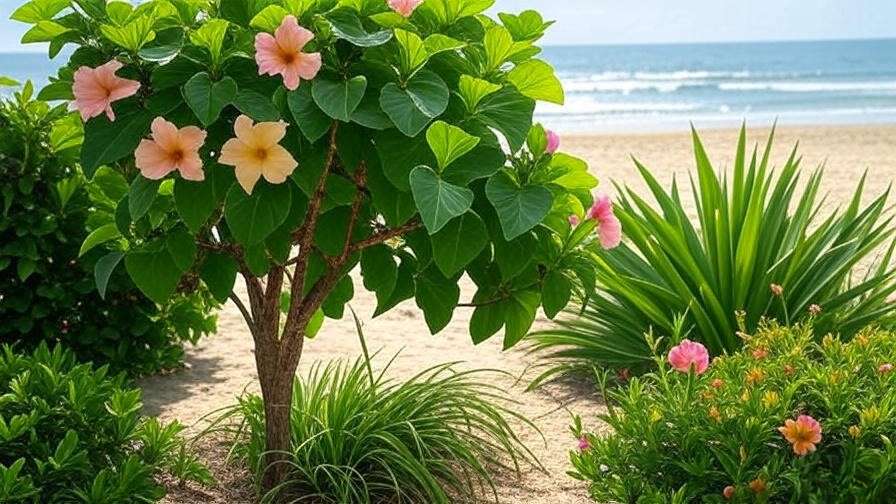
5. Royal Poinciana (Delonix regia)
Known as the “flame tree,” the Royal Poinciana’s fiery red-orange blooms and wide canopy make it a stunning shade provider.
- Growing Conditions: Full sun, well-drained soil, warm climates.
- Care Tips: Prune to manage size, water deeply but infrequently.
- Note: Its large root system requires ample space, so avoid planting near structures.
6. Blue Jade Vine (Strongylodon macrobotrys)
The Blue Jade Vine, with its rare turquoise flower clusters, is a show-stopping vine that can be trained into a tree-like form. Its otherworldly hue makes it a must-have for exotic gardens.
- Growing Conditions: Humid, shaded areas with trellis or support structures.
- Care Tips: Water consistently, provide sturdy support, and protect from strong winds.
- Expert Tip: Use a trellis to shape it into a tree form, creating a focal point in shaded gardens. 🌿
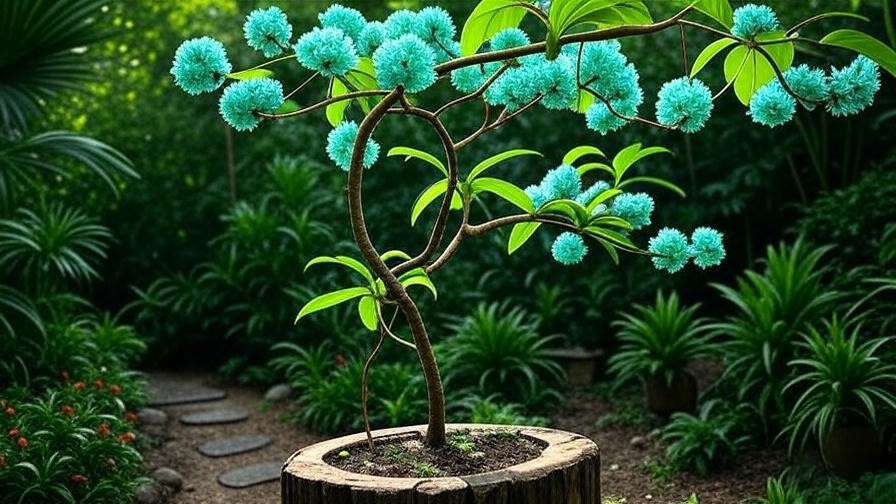
7. African Tulip Tree (Spathodea campanulata)
This fast-growing tree dazzles with bright orange-red, trumpet-shaped flowers. While stunning, it can be invasive in some areas, so care is needed.
- Growing Conditions: Full sun, adaptable to various soils, moderate water.
- Care Tips: Remove seed pods to prevent unwanted spread, prune to maintain shape.
- Caution: Check local regulations, as it’s considered invasive in parts of Hawaii.
8. Koa (Acacia koa)
The Koa tree, prized for its rich wood and subtle yellow puffball flowers, is a Hawaiian native with deep cultural roots, used in traditional crafts like canoes and ukuleles.
- Growing Conditions: Well-drained soil, full sun to partial shade.
- Care Tips: Deep water young trees, monitor for koa moth or beetle infestations.
- Cultural Note: Koa is a symbol of resilience in Hawaiian culture, often planted for restoration projects. 🌳
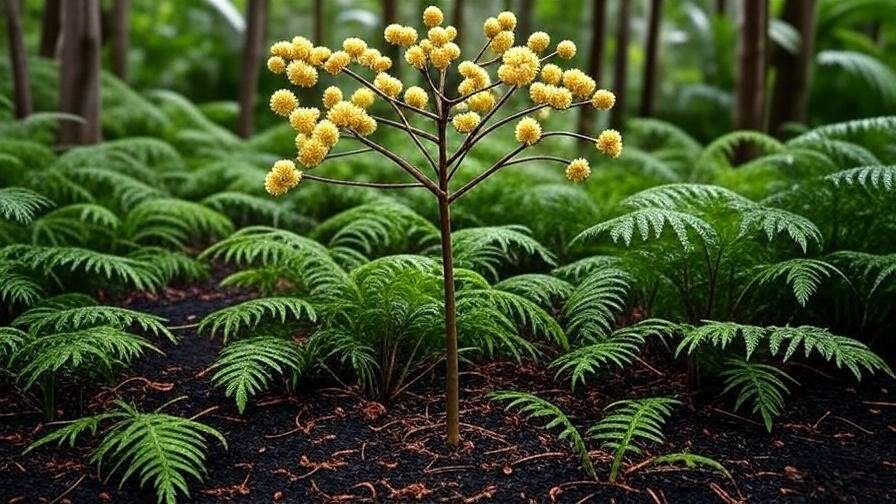
9. Jacaranda (Jacaranda mimosifolia)
The Jacaranda’s lavender-blue flower clusters and fern-like leaves create a dreamy, tropical vibe. Its vibrant blooms make it a favorite for ornamental gardens.
- Growing Conditions: Warm climates, well-drained soil, full sun.
- Care Tips: Prune after flowering to encourage growth, protect from frost in cooler regions.
- Visual Appeal: Its purple blooms pair beautifully with green lawns for a striking contrast.
10. Golden Trumpet Tree (Tabebuia chrysotricha)
This compact tree bursts with bright yellow, trumpet-shaped flowers, making it ideal for smaller gardens or patios.
- Growing Conditions: Full sun, moderate water, well-drained soil.
- Care Tips: Fertilize during bloom season, stake young trees to support growth.
- Benefit: Its smaller size makes it perfect for urban or container gardening. 🌼
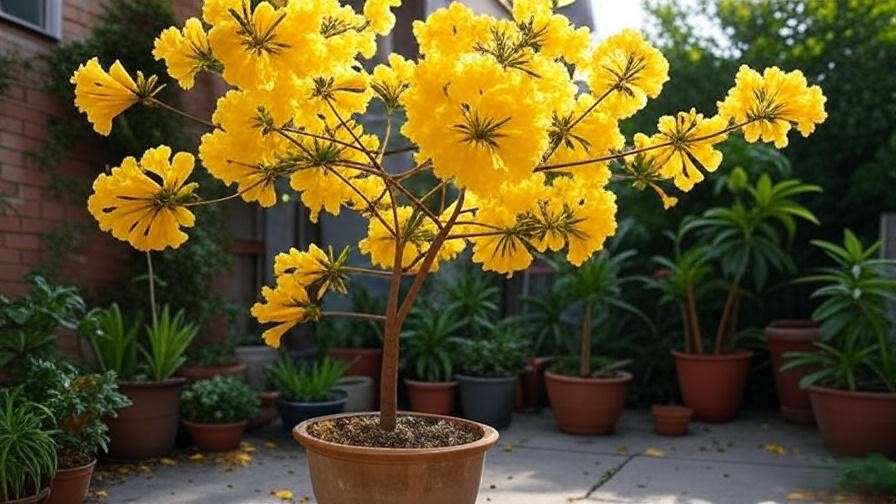
How to Choose the Right Hawaiian Flowering Tree for Your Garden 🌴
Selecting the perfect tree involves balancing aesthetics, space, and climate. Here’s how to make an informed choice.
Assessing Your Space
Evaluate your garden’s size, sunlight, and soil type. Small spaces suit compact trees like the Golden Trumpet or Plumeria, while larger yards can accommodate Royal Poinciana or Rainbow Shower Trees. Measure available space to avoid overcrowding, ensuring roots and canopies have room to grow. For example, a 10×10-foot patio can host a potted Plumeria, while a half-acre lot suits a sprawling Koa.
Climate Considerations
Hawaiian flowering trees thrive in USDA zones 9-11, but many can adapt to cooler climates with care. In non-tropical regions, grow sensitive trees like Plumeria in containers to bring indoors during winter. Create microclimates using windbreaks or south-facing walls to mimic tropical conditions. For instance, a sheltered patio can extend the growing range for Jacaranda in zone 8.
Aesthetic and Functional Goals
Define your garden’s purpose: shade, privacy, or ornamental beauty. For shade, choose Royal Poinciana or Koa. For privacy, Hibiscus Trees create dense screens. For color, pair Plumeria’s pastel blooms with Jacaranda’s purples for year-round vibrancy. Plan bloom times to ensure continuous color—Ohia Lehua blooms sporadically, while Rainbow Shower Trees peak in summer.
Planting and Care Tips for Hawaiian Flowering Trees 🌱
Proper planting and maintenance are key to vibrant, healthy trees. Follow these expert tips to ensure success.
Planting Best Practices
- Site Selection: Choose a spot with appropriate sunlight (full sun for most trees) and good drainage.
- Soil Preparation: Amend soil with organic matter like compost to improve drainage and fertility.
- Planting Depth: Dig a hole twice as wide as the root ball but no deeper, ensuring the root crown sits at soil level.
- Spacing: Space trees according to mature size (e.g., 20 feet apart for Royal Poinciana).
- Tip: Water thoroughly after planting to settle roots, and mulch to retain moisture.
Watering and Fertilizing
Most Hawaiian flowering trees need moderate watering, with young trees requiring more frequent irrigation. Water deeply once or twice weekly, adjusting for rainfall. Use a balanced fertilizer (e.g., 10-10-10) monthly during the growing season to boost blooms. For Plumeria, a high-phosphorus fertilizer (e.g., 10-30-10) enhances flowering. Avoid over-fertilizing, which can lead to excessive foliage at the expense of blooms.
Pruning and Maintenance
Prune to remove dead branches, maintain shape, and encourage flowering. For example, trim Rainbow Shower Trees in late winter to promote summer blooms. Use clean, sharp tools to prevent disease. Monitor for pests like aphids (common on Hibiscus) or scale (on Plumeria), and treat with neem oil or insecticidal soap. Check for fungal issues in humid climates, especially for Ohia Lehua.
Seasonal Care
In tropical climates, adjust watering during wet and dry seasons—reduce irrigation in rainy periods to prevent root rot. In cooler regions, protect trees from frost by wrapping trunks or moving potted trees indoors. Mulch heavily in fall to insulate roots. For example, Jacaranda benefits from a 3-inch mulch layer in zone 9 winters.
Designing a Tropical Garden with Hawaiian Flowering Trees 🌺
Create a cohesive, island-inspired garden by combining these trees with complementary elements.
Creating a Cohesive Look
Pair Hawaiian flowering trees with tropical plants like bird of paradise, ferns, or ti plants for a lush effect. For example, plant Plumeria as a centerpiece with low-growing hibiscus shrubs for a layered look. Alternate bloom colors—combine Ohia Lehua’s reds with Golden Trumpet’s yellows—for visual harmony. Plan for staggered bloom times to maintain year-round color.
Incorporating Hardscaping
Enhance your garden with pathways, water features, or seating areas. A stone path winding through Plumeria and Hibiscus creates a tropical trail. Add a small fountain near a Rainbow Shower Tree to mimic Hawaii’s natural beauty. Use lava rocks or coral stones for an authentic island aesthetic. 🌊
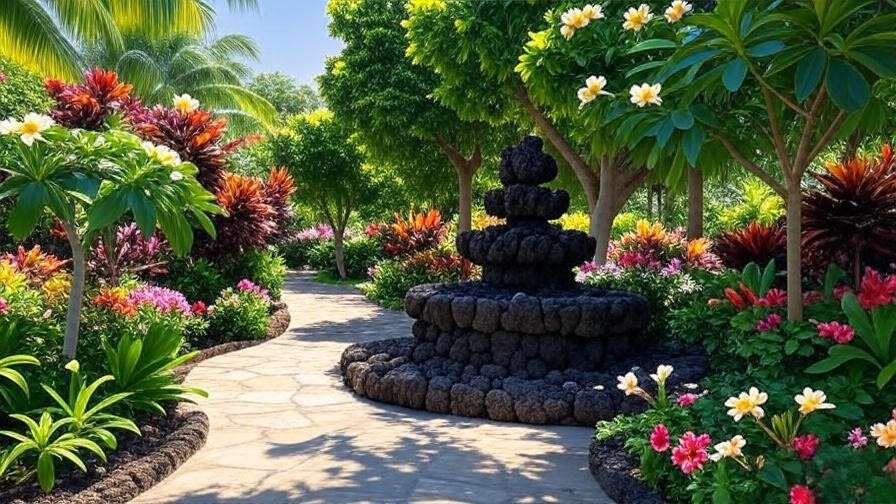
Sustainable Landscaping
Opt for native trees like Ohia Lehua or Koa to reduce water and maintenance needs. These species are adapted to Hawaii’s climate, requiring less intervention. Incorporate drip irrigation to conserve water, and use organic mulch to suppress weeds. Dr. Kalani Souza, a Hawaiian landscape ecologist, emphasizes, “Native trees like Koa support biodiversity and connect us to the land’s cultural heritage.”
Common Mistakes to Avoid When Growing Hawaiian Flowering Trees 🚫
- Overwatering: Excess water causes root rot, especially in poorly drained soils. Test soil moisture before watering.
- Wrong Climate: Planting tropical trees in cold climates without protection leads to failure. Use containers or greenhouses for sensitive species.
- Neglecting Pruning: Unpruned trees like African Tulip can become leggy or invasive. Schedule annual pruning.
- Ignoring Pests: Aphids, scale, or fungal diseases can damage trees. Inspect regularly and treat early with organic solutions.
FAQs About Hawaiian Flowering Trees ❓
- What are the easiest Hawaiian flowering trees to grow for beginners?
Plumeria and Golden Trumpet Tree are low-maintenance and forgiving for new gardeners. - Can I grow Hawaiian flowering trees in non-tropical climates?
Yes, with container planting or microclimates, especially for Plumeria and Jacaranda in zones 8-9. - How long does it take for these trees to bloom?
Most bloom within 1-3 years with proper care; Plumeria can flower in its first year from cuttings. - Are any Hawaiian flowering trees invasive?
African Tulip Tree can be invasive in some areas; check local regulations before planting. - What’s the best time of year to plant these trees?
Spring or early summer ensures optimal growth in tropical climates; fall for cooler regions. - How do I propagate Hawaiian flowering trees like Plumeria?
Take 12-18 inch cuttings, dry for a week, and plant in well-drained soil with indirect light.
Conclusion: Transform Your Garden with Hawaiian Flowering Trees 🌞
Hawaiian flowering trees like Ohia Lehua, Plumeria, and Rainbow Shower Trees bring vibrant beauty, cultural depth, and ecological benefits to any garden. Whether you’re creating a tropical oasis in Hawaii or a container garden in a cooler climate, these trees offer endless possibilities. Start with beginner-friendly options like Plumeria, follow our expert planting and care tips, and design a sustainable, stunning landscape. As a certified arborist with years of experience in tropical plant care, I encourage you to explore these trees and share your garden journey in the comments below. Visit our site for more plant care guides, and let’s bring the aloha spirit to your backyard! 🌴













